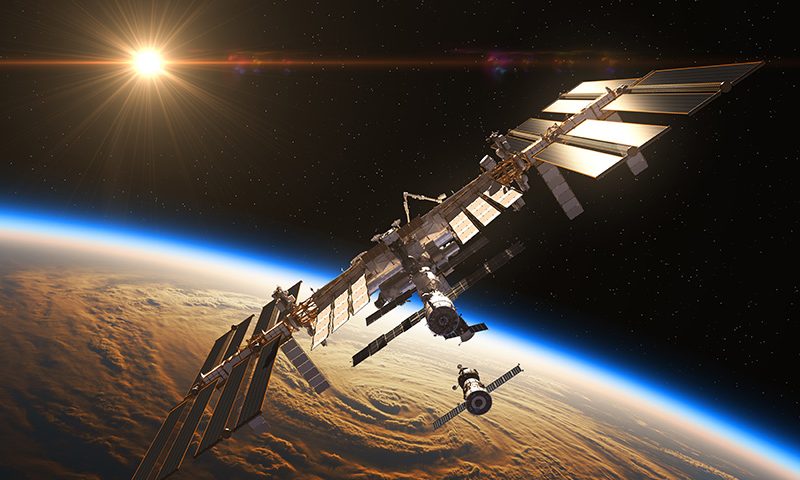Astronauts on the International Space Station work out two hours a day to fend off the bone and muscle loss that happens outside the pull of Earth’s gravity. But what if a drug could replace that exercise? A group of musclebound mice might hold the answer—and it could not only help astronauts that face longer and longer missions, but also people suffering from a range of diseases back on Earth.
A team led by scientists at the Jackson Laboratory for Genomic Medicine and the University of Connecticut found that blocking a pathway that limits muscle growth in mice helped them maintain their bone and muscle mass over a month spent in microgravity. The pathway in question, the myostatin/activin A signaling pathway, evolved as a survival mechanism that helps animals maintain fat reserves from when meals are few and far between. They published the findings in the Proceedings of the National Academy of Sciences (PNAS).
“Myostatin and actavin A are two members of what we call a family of signaling molecules, meaning they are similar to one another in their structure and they function in a similar way,” said Se-Jin Lee, M.D., Ph.D., a professor of genetics and genome sciences and the Jackson Lab and University of Connecticut.
Both signaling proteins bind to a receptor on the surface of muscle cells to trigger various processes inside the cell. One of those processes stops animals from becoming too heavily muscled.
“Myostatin regulates muscle growth, so when you lack it, it causes muscle to grow larger than it normally does… You end up with a shift in balance in the body with more muscle and less fat,” Lee said.
That’s bad news for animals without a ready supply of food: Not only do they lose their fat reserves, but they also carry more muscle, a tissue that needs a lot of energy to work. For humans, though, it’s a different story.
“We live in air-conditioned and heated homes; we go to Starbucks whenever we want,” Lee said. “The way we view it is we don’t really need this regulatory system anymore, even though there was this incredible evolutionary pressure to maintain this gene. In theory, we can manipulate this gene and this protein with relative impunity.”
Lee and his colleagues did that in two ways: they knocked out the myostatin gene in some “mighty mice,” causing them to develop larger muscles than normal mice, and they treated other mice with a drug that inhibits myostatin.
Blocking myostatin is not a new idea. Multiple biopharma companies have tried to develop myostatin inhibitors, but most of these have been monoclonal antibodies that seek to block myostatin without also hitting actavin A. Lee’s team tested a decoy receptor that binds both proteins, which results in a greater effect on muscle growth and has the added benefit of boosting bone density.
Working with NASA and SpaceX, the team sent 40 mice to the International Space Station: 24 were normal, wild-type mice, 8 were “mighty mice, and 8 would be injected with the myostatin inhibitor in microgravity. After 33 days in orbit, the mice returned to Earth for analysis. The researchers kept a group of mice on Earth to serve as a “ground control.”
When they blasted off, the mighty mice had about twice the amount of muscle than the other mice. Although they didn’t conserve that muscle as well as the mighty mice that stayed on Earth did, their “enhanced muscling” was “largely (if not entirely) maintained following exposure to microgravity,” the researchers wrote in their study.
As for the mice that received the myostatin inhibitor, those in orbit did better than their counterparts on Earth. After 22 days, they saw their lean body mass increase 27%, compared to just 18% for the mice treated on Earth. The untreated mice fared the worst, losing 9% of their lean body mass in microgravity.
The mice that stayed on Earth had higher bone densities than their counterparts that spent a month in orbit. However, the difference between the bone densities of treated and untreated mice was larger in the space group than in the ground control mice, “demonstrating that treatment with the [myostatin inhibitor] afforded significant protection against bone loss due to microgravity,” the researchers wrote.
The main takeaway, Lee said, is that the drug works for growing muscle and building bone even in the absence of gravity.
The findings could help astronauts maintain their bone density and muscle mass during tours on the International Space Station, as well as those who carry out longer missions in the future, such as trips to Mars that would last years.
The research could also pave the way for new treatments for diseases such as osteogeneis imperfecta, or brittle bone disease.
“When they break a bone, they end up being immobile, the muscle atrophies and they can’t get back to baseline and heal. Their bones continue to become more and more fragile and their muscles continue to atrophy,” said Emily Germain-Lee, Ph.D., a pediatric endocrinologist and a professor at the University of Connecticut School of Medicine.
The approach could also be helpful for children with muscular dystrophy and anyone with a condition that features muscle wasting or bone fragility.
“Anyone who is aging, for instance, or anyone who is ill for any reason and ends up bedridden,” Germain-Lee said. “It has tremendous implications in terms of what it could do therapeutically.”
As for the team’s next steps, they “would love to think about another project sending mice into microgravity,” Lee said. “We had some specific plans for what the next follow-up study would be, but as we got more data from this study and the analysis of proteins in the blood, so many interesting follow-up questions came up that we are rethinking how we want to do this.”

